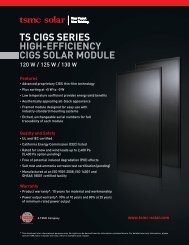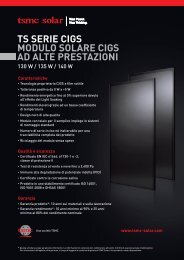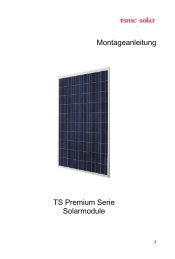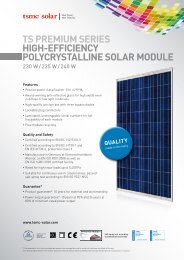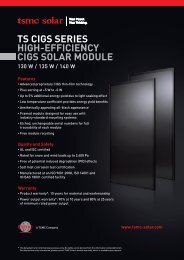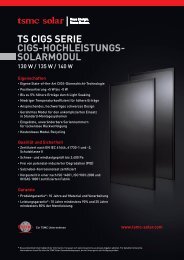UL 1703 æå - tsmc solar
UL 1703 æå - tsmc solar
UL 1703 æå - tsmc solar
- No tags were found...
Create successful ePaper yourself
Turn your PDF publications into a flip-book with our unique Google optimized e-Paper software.
Installation and Safety ManualTS CIGS SeriesTS-110CTS-115CTS-120CTS-125CTS-130CTS-135CTS-140C
6.A Module Product SpecificationMeasured at STC: Irradiance 1000W/m 2 and cell temperature 25°C (77°F) AM=1.5All ratings +/- 10%, unless specified otherwise. Specifications are subject to change.6.B Electrical InstallationUnder normal conditions, a module is likely to experience conditions that produce more current and/or voltagethan reported at standard test conditions (STC). Accordingly, the values of ISC and VOC marked on this modulemust be multiplied by a factor of 1.25 when determining component voltage ratings, conductor capacities, fusesizes, and size of controls connected to the PV output.The multiplying factor at conditions of an irradiance of 1250 w/m 2 , AM1.5 spectrum, and a cell temperature of-10°C (+14°F) for Voc is 1.25 and at cell temperature of 75°C (167°F) for Isc it is 1.25.In the United States, refer to Section 690-8 of the National Electrical Code for an additional multiplying factor of1.25 (80% derating) which may be applicable.For field connections, use approved PV Copper wire only, minimum No. 14 AWG (2.5mm 2 ) wires insulated forminimum of 90°C6.C Electrical Wiring MethodTo ensure proper system operation, correct cable connection polarity (Figure 2) must be observed whenconnecting the modules to other modules. If not connected correctly, the bypass diode could be destroyed. Ifmodules are connected in series, the total voltage is equal to the sum of the individual module voltages. Onlyconnect modules or series combinations of modules with the same voltage. If modules are connected in parallel,the total current is equal to the sum of individual module current.- 5 -
Series Wiring (voltage additive)Parallel Wiring (current additive)Figure 2 Wiring Methods6.D Correct Wiring SchemeIn order to decrease voltage caused by indirect lightning strikes, all connecting cables should be as short aspossible. Check that the wiring is correct before commissioning the system. If the measured open circuit voltagediffers from the specifications, then there is a wiring fault. Match the polarities of cables and terminals whenmaking the connections; failure to do so may result in damage to the module6.E Junction BoxBypass diode dataTypeP 1000 MManufacturer SemikronVoltage rating 1000 (V)Current rating 10 (A)Configuration Single in J-boxFigure 3 Junction Box and Bypass Diode6.F Mechanical InstallationThere are two mechanical installations, one is the clamp type, and another is the bolt type. About the installedposition is below:- 6 -
Clamp Type:Modules can be mounted with clamps, the center of clamp located as shown in Figure 4. This method enables amaximum mechanical loading of 2,400N/m2 (50PSF) ( IEC),.All measurementsin mm [inches]Figure 4 Clamping ZoneBolt Type:The module can be mounted by bolt too, the position of hole which denote “M1” as shown in Figure 5. Thismethod enables a maximum mechanical loading of 2,400N/m2 (50PSF) ( IEC) too, in a static state on the modulesurface.The frame of each module has 8 x 6.6 mm [0.26”] mounting holes. Future products will support a mountingmethod using these mounting holes to secure the modules to supporting structures.- 7 -
22.5611 (MOUNTING HOLE)841 (MOUNTING HOLE) 407.5M1M1M1M1Figure 5 Bolt Installed PositionNo matter which one, the modules are recommended to be mounted in portrait orientation (short side parallel toground) for best performance. If modules are mounted in landscape orientation (long side parallel to ground),shading must be minimized as this orientation can significantly increase the impact of shading on moduleperformance.6.G Tilt Angle SelectionThe module tilt angle is measured between the modules and the ground as shown in Figure 6, with the modulesgenerating the maximum power when they face sunlight directly (incident light perpendicular to module frontsurface).For installations where the modules are mounted on a permanent structure, they should be tilted so that theenergy production from the modules will be maximized on an annual basis. Generally this result will be achievedwhen the tilt angle is near the value of the latitude of the mounting site.Tilt angles of at least 10° are recommended to reduce dirt or other substance accumulation.- 8 -
Figure 6 Tilt Angle Definition6.H Fire Class RatingThese modules have achieved a Fire Resistance Rating of Class C (<strong>UL</strong>).In rooftop installations, installed modules must have a standoff height between roof and module of more than 9cm[3.54”], for airflow passage.Note: during <strong>UL</strong> testing, the slope of the fire class test for this module is 5 in/ft.ModuleRoofStandoff Height9cm [3.54”]Figure 7 Standoff Height7. GroundingThe company installing the modules will be responsible for professional grounding the modules. Thefactory-provided aluminum frame must be grounded.All grounding must be performed to be compliant with the latest regulations that are applicable for the jurisdictionin the United States, the National Electrical Code (NEC).If the building is already equipped with an exterior lightning protection system, the PV installation must beintegrated into the protection system against direct effects of lightning.There are eight 4.2mm [0.165”] grounding holes on the module frame, located and marked as shown in Figure 8.Figure 9 illustrates grounding the module. Ground wires must be connected to the module’s frame at one of theseholes. The ground wire must not be smaller than No.14 AWG (2.5 mm²), and sized according local regulations,the NEC (National Electric Code) in the United States.The ground holes must be used with M4 screws. The length of the screws must not exceed 20 mm [0.78”] in orderto avoid contacting the back glass of the module. The shortest length of screws must not be less than 12 mm- 9 -
[0.47”]. The torque to be applied to the M4 screw is 3.0~4.0 N-m [22.1~26.6 in-lb]The material of the frame is aluminum alloy. To avoid galvanic corrosion, all fasteners (nuts, bolts, washers,screws, etc.) must be stainless steel unless otherwise specified.All measurements in mm [inches]Figure 8 Grounding Mark and DimensionFigure 9 Grounding with Washers8. Mounting and ConfigurationsBecause there are two mechanical installation methods which were mentioned by previous, the method ofmounting and configuration is explained as below, respectively.Clamp Type:The module must be secured to the mounting structure by clamping. A clamping solution requires a top clamppiece that braces the front of the module frame and a rail or bottom clamp piece that supports or clamps thebottom of the module. The top clamp piece hold the module securely at four points against rails or bottom clamps.An example of both top down end-clamping and middle-clamping is shown in Figure 12.- 10 -
Mechanical means to be used are as below and as shown in Table 1:·Screw/Bolt: M6 Stainless SteelNut:M6 Stainless Steel Flange NutWasher: M6 Stainless Flat WasherTorque Value: 6 ~ 7 N-m [53.1~61.9 in-lb]Clamps: AluminumAll measurements in mm [inches]50 [1.96"]M6 NUT M6 WASHER TOP CLAMP50 [1.96"]M6 FLANGE NUT BOTTOM CLAMP M6 BOLT (L: 55~65mm) [2.16"~2.56"]50 [1.96"]30 [1.18"]60 [2.36"]MIDDLE CLAMPMOUNTING STRUCTURE BEAMTable 1 Mounting Mechanical Means- 12 -
All measurements in mm [inches]Figure 12 Module Mounting Method (Clamp Type)Bolt Type:The module could be mounted on the structure by the bolt. This method needs M6 bolt, M6 spring washer, M6 flatwasher and M6 nut. There are eight holes at the back side of module, but need only 4 holes for the installation asFigure 1. These 4 holes offset the short edge of module is 40.75cm [16.04”]. The installed method is that the boltmust be put on the spring washer first, and then from the mounting hole of module through the aluminum frame,and then through the system rail, and then put the flat washer and nut, and finally use torque 6 Nm to screw tightthe nut to complete installation as Figure 13. The cross section of installation is as Figure 14.- 13 -
9. Definition of Serial NumberContact InformationEuropeTSMC Solar Europe GmbHAm Kaiserkai 120457 Hamburg, GermanyTel: +49 (0) 40/80 80 745 40Fax: +49 (0) 40/80 80 749 20SolarEU@<strong>tsmc</strong>.comNorth AmericaTSMC Solar North America Inc.2595 Junction AvenueSan Jose, CA 95134 USATel: +1 408 678 2816Fax: +1 408 678 2800SolarNA@<strong>tsmc</strong>.comAsia / InternationalTSMC Solar Ltd.No. 5 Keya W. Rd, Daya DistrictTaichung, Taiwan 428-82 ROCTel: +886 3 563 6688Fax: +886 4 2569 3884SolarAsia@<strong>tsmc</strong>.comwww.<strong>tsmc</strong>-<strong>solar</strong>.com- 15 -IM-TSC-EN-05/12-01




